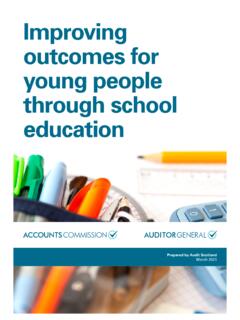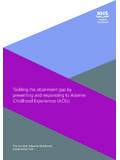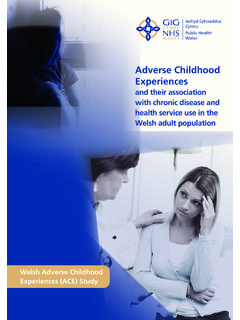Transcription of Sharing nudes and semi-nudes
1 Sharing nudes and semi-nudesAdvice for education settings working with children and young peopleResponding to incidents and safeguarding children and young peopleUK Council forInternet SafetyNaked picturesNude selfiesNudesInappropriate picturesSextingPics, pics, pics!Indecent images PicsToplessDisclaimer Relevant laws and best practice have been taken into account in the development of this document. However, these issues have the potential to be complex and multi-faceted. As case law in this area is still relatively underdeveloped, nothing in this document should be taken as legal advice. The authors and other contributors to this document accept no liability for any damage or loss suffered or incurred whether directly, consequentially, indirectly or otherwise by anyone relying on the information in this publication or any other information referred to in it. Web addresses, social networks, apps and other references in this document were correct at the time of publication but may be subject to change over time.
2 This document was last updated and published in December 2020. Production of this document has been coordinated by the UK Council for Internet Safety s Education Working Group in partnership with the NPCC. CONTENTS SECTION ONE BACKGROUND AND 4 Who is this for? .. 4 What does this advice cover? .. 4 What is the status of this advice? .. 5 Sharing nudes and semi- nudes : definition .. 6 (a) Alternative definitions .. 7 Why does this matter to settings working with children ? .. 7 Understanding motivations and behaviours .. 8 (a) Defining the incident .. 9 (b) Assessing behaviour ..10 The law ..12 (a) Indecent images of children ..12 (b) Non-consensual image Sharing ..13 Avoiding unnecessary criminalisation of children ..13 The police response ..13 (a) Crime recording ..14 (b) Police decision ..14 (c) Criminal records check ..15 (d) Multi-agency working ..16 SECTION TWO HANDLING INCIDENTS .. 17 Initial response ..17 Disclosure ..18 Initial review meeting.
3 19 Assessing the risks ..20 Supporting the young person/ people involved ..21 Informing parents and carers ..24 Supporting parents and carers ..24 Multi-agency working ..27 children s social care contact and referrals ..28 Searching devices, viewing and deleting nudes and semi- nudes ..28 3 (a) Viewing the (b) Deletion of imagery ..30 Recording incidents ..31 Reporting nudes and semi- nudes online ..31 Best practice responses to incidents ..31 SECTION THREE EDUCATING children AND young people .. 35 Why educate children and young people about the Sharing of nudes and semi- nudes ? ..35 When and where should we teach children and young people about the Sharing of nudes and semi- nudes ? ..35 How can we deliver education safely? ..37 Using external What resources are available? ..39 Annex A: Questions to support assessment .. 41 Annex B: Training exercise .. 46 Annex C: Table of substantive changes from Sexting in Schools and Colleges .. 55 4 SECTION ONE BACKGROUND AND CONTEXT Who is this for?
4 This advice is for designated safeguarding leads (DSLs), their deputies, headteachers and senior leadership teams in schools and educational establishments1 in England. Other members of staff should see a one-page summary on how to manage incidents available on the UK C ouncil for Internet Safety s (UKCIS ) website. This document may also act as good practice advice for out-of-school settings providing education for children and young people in England extracurricular clubs, youth organisations and providers. Practitioners working in education settings in Wales should see the following advice on responding to incidents: Sharing nudes and semi- nudes : responding to incidents and safeguardingchildren and young people (Welsh Government as part of UKCIS)Practitioners working in education settings in Scotland should see the following guidance and advice for responding to incidents and safeguarding children and young people in Scotland: National Guidance for Child Protection in Scotland ( scottish Government)2 Healthy relationships and consent: key messages for young people (ScottishGovernment) Upstream (Stop It Now!)
5 And the scottish Government) What s the problem? (Stop It Now!) Internet safety for children and young people : national action plan (ScottishGovernment) What does this advice cover? This advice outlines how to respond to an incident of nudes and semi- nudes being shared (see section for a definition), including: risk assessing situations safeguarding and supporting children and young people handling devices and images recording incidents, including the role of other agencies1 Schools and educational establishments refers to schools and colleges and includes: maintained schools and colleges, independent schools (including academies, free schools), alternative provision academies and non-maintained special schools and Pupil Referral Units. 2 Currently under review and due to be published in 2021 5 informing parents and carersThe types of incidents which this advice covers are: a person under the age of 18 creates and shares nudes and semi- nudes ofthemselves with a peer under the age of 18 a person under the age of 18 shares nudes and semi- nudes created by anotherperson under the age of 18 with a peer under the age of 18 a person under the age of 18 is in possession of nudes and semi- nudes createdby another person under the age of 18 This advice does not cover.
6 The Sharing of nudes and semi- nudes of under 18s by adults (18 and over) as thisconstitutes child sexual abuse and education settings should always inform theirlocal police force as a matter of urgency3 children and young people under the age of 18 Sharing adult pornography orexchanging sexual texts which do not contain imagesIn response to these issues, education settings should follow their local authority s guidance and schools and colleges should also refer to the Department for Education s (DfE s) Keeping children Safe in Education statutory safeguarding guidance. What is the status of this advice? The production of this advice has been co-ordinated by the UKCIS Education Working Group in consultation with the National Police Chiefs' Council (NPCC) on behalf of UKCIS. This advice is non-statutory, and schools and colleges should read this alongside: Keeping children Safe in Education statutory guidance (DfE) Sexual violence and sexual harassment between children in schools andcolleges non-statutory advice (DfE) Searching, Screening and Confiscation non-statutory advice (DfE).
7 The advice replaces Sexting in schools and colleges: responding to incidents and safeguarding young people published in 2016 by UKCIS in collaboration with the NPCC and Charlotte Aynsley. 3 This also includes instances where a person under the age of 18 shares nudes or semi- nudes created by a peer under the age of 18 with an adult 6 Sharing nudes and semi- nudes : definition This advice uses the term Sharing nudes and semi- nudes to mean the sending or posting of nude or semi-nude images, videos or live streams by young people under the age of 18 online. This could be via social media, gaming platforms, chat apps or forums. It could also involve Sharing between devices via services like Apple s AirDrop which works offline. The term nudes is used as it is most commonly recognised by young people and more appropriately covers all types of image Sharing incidents. Alternative terms used by children and young people may include dick pics or pics . The motivations for taking and Sharing nude and semi-nude images, videos and live streams are not always sexually or criminally motivated.
8 Such images may be created and shared consensually by young people who are in relationships, as well as between those who are not in a It is also possible for a young person in a consensual relationship to be coerced into Sharing an image with their partner. Incidents may also occur where: children and young people find nudes and semi- nudes online and share themclaiming to be from a peer children and young people digitally manipulate an image of a young person intoan existing nude online images created or shared are used to abuse peers by selling images onlineor obtaining images to share more widely without consent to publicly shameFurther guidance on the motivations for taking and Sharing images and videos can be found in section The Sharing of nudes and semi- nudes can happen publicly online, in 1:1 messaging or via group chats and closed social media accounts. Nude or semi-nude images, videos or live streams may include more than one child or young person.
9 Creating and Sharing nudes and semi- nudes of under-18s (including those created and shared with consent) is illegal which makes responding to incidents involving children and young people complex. There are also a range of risks which need careful management from those working in education settings. 4 Consent is defined as an agreement made by choice, whereby an individual has the freedom and capacity to make that choice. This is outlined in of the Sexual Offences Act 2003. This mean the child or young person must have the capacity ( the age and understanding) to make the choice and be in the position to make that choice freely without exploitation, threat or fear. 7 (a) Alternative definitions Many professionals may refer to nudes and semi- nudes as: youth produced sexual imagery or youth involved sexual imagery indecent imagery. This is the legal term used to define nude or semi-nudeimages and videos of children and young people under the age of 18. Furtherguidance on the law can be found in section sexting.
10 Many adults may use this term, however some young people interpretsexting as writing and Sharing explicit messages with people they know ratherthan Sharing images image-based sexual abuse. This term may be used when referring to the non-consensual Sharing of nudes and semi-nudes5 Terms such as revenge porn and upskirting 6 are also used to refer to specific incidents of nudes and semi- nudes being shared. However, these terms are more often used in the context of adult-to-adult non-consensual image Sharing offences outlined in of the Criminal Justice and Courts Act 2015, Voyeurism (Offences) Act 2019and of the Sexual Offences Act Why does this matter to settings working with children ? Sharing photos, videos and live streams online is part of daily life for many people , enabling them to share their experiences, connect with friends and record their lives. Photos and videos can be shared via messaging apps or posted on social media and image Sharing platforms.












